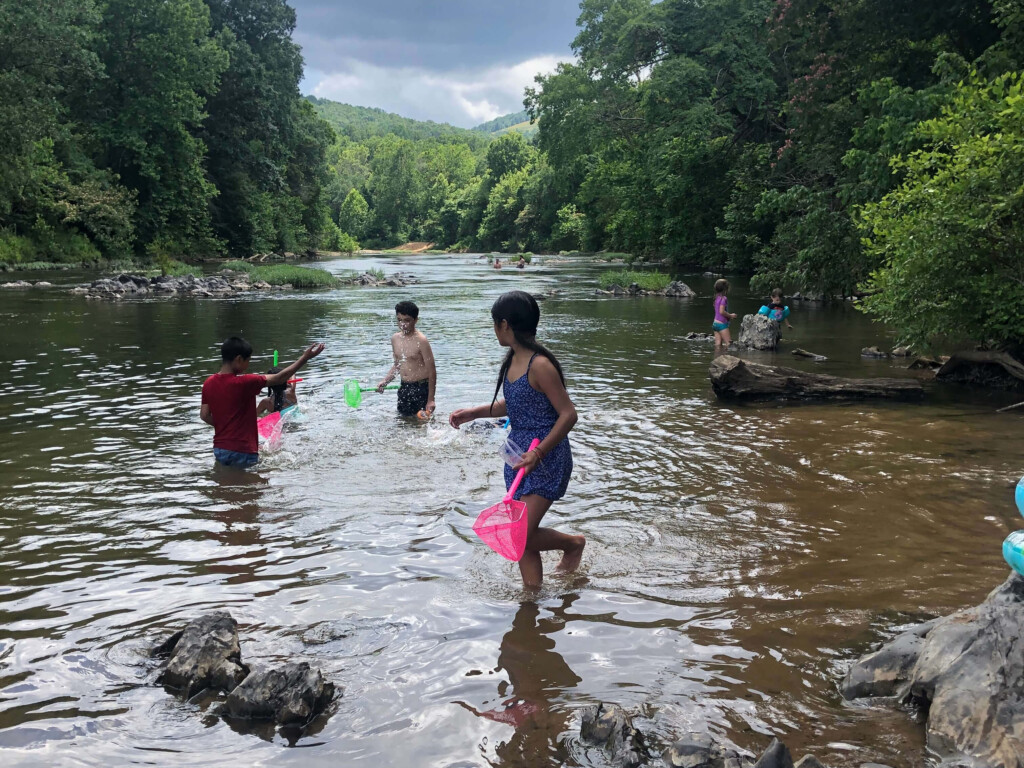Project Update
Thanks to the hundreds of community members whose input helped shape the Riverview Restoration Project’s conceptual design (scroll to bottom of page for details about community input). This design is informed by technical analyses of river conditions; a topographic survey; extensive community input on design priorities; riverbank restoration best practices; park user circulation patterns; and location of utility lines, easements, and other existing park features.
The project is now seeking funding to complete the engineering design, permitting, and construction of the project. The goal is to complete design and permitting starting in 2024, with construction in late 2025.

Project Overview
As the City of Charlottesville’s only public access point to the Rivanna River, there is a lot to love about Riverview Park. The Park offers the community a welcoming place to exercise, cool off, paddle, fish, play, explore, observe nature, and escape from the day-to-day stresses of life.
Anyone who has spent time in Riverview Park has likely noticed signs that the Park is suffering from high rates of riverbank erosion and other challenges, including:
- Trees that are being undermined and falling into the water
- Portions of the trail and the river access stairs that have washed away during large storms
- Invasive species that have damaged the forests and meadows
- Sediment that has degraded habitat for fish and other aquatic organisms
- Steep, dangerous banks that have cut us off physically and visually from the River
These challenges threaten not only the integrity of the Park itself, but also the community’s use and enjoyment of it.
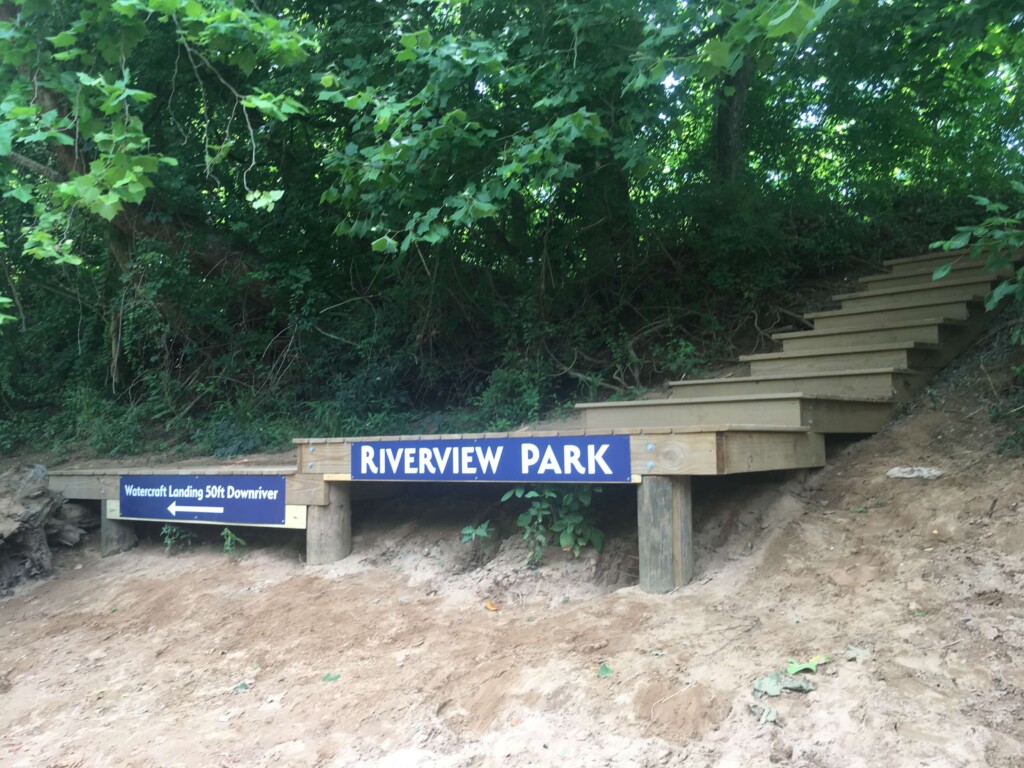
In December 2021, these public access stairs were washed completely away in a storm, never to be found.
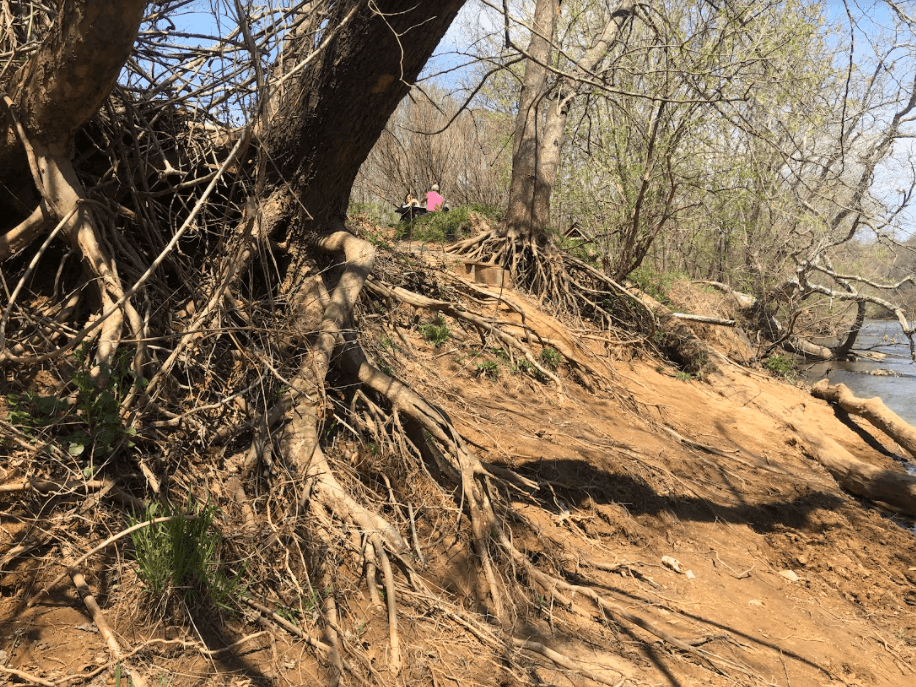
Erosion is undermining trees growing along the riverbanks, causing them to topple into the water. Significant amounts of soil wash in from the banks, contributing to water pollution and damage to aquatic habitat.
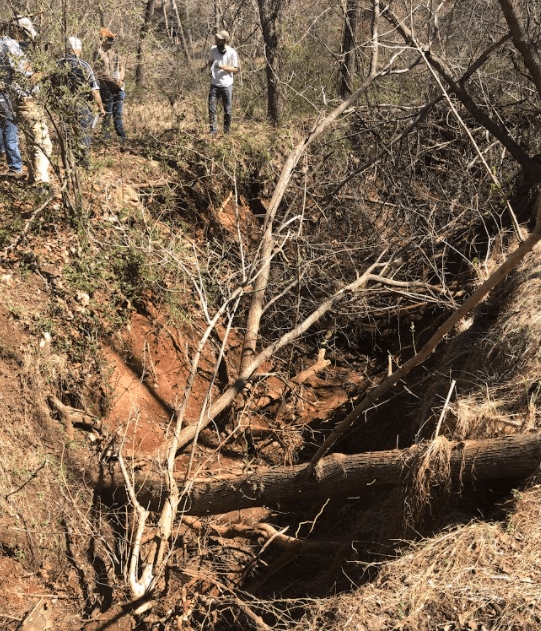
The eroding stormwater channel creates a safety hazard for Park visitors and contributes to water pollution.
The goal of the Rivanna Restoration at Riverview Park project is to explore, prioritize, and implement options for addressing these problems. The project aims to restore a 600-foot section of the Rivanna’s riverbank in the area of the public access stairs and a 200 foot section of a dangerously eroding stormwater channel nearby. By selecting and implementing appropriate natural stream restoration approaches, we can help:
- Protect the land, trees, and trails from erosion
- Reduce water pollution
- Improve opportunities for boating, wading, and observing wildlife
- Enhance habitat for birds, fish, and other wildlife
- Protect public safety and existing infrastructure
With input and support from the community, local partners, and funders, together we can restore Riverview Park and reconnect our community with our river.
Project Background
In 2020 and 2021, the Rivanna Conservation Alliance collaborated with Ecosystem Services on the Rivanna Prioritization Study and Capacity Building Project. Funded by a National Fish and Wildlife Foundation (NFWF) Planning and Technical Assistance grant, this effort inventoried, assessed, and prioritized potential restoration project areas along a five-mile stretch of the Rivanna River from the confluence of the North and South Forks to Moores Creek.
The project team scored 31 project areas on ten criteria developed with stakeholder input. Criteria included: habitat creation, water quality, recreation access, public safety improvements, aesthetic uplift potential, ease of access, likelihood of landowner participation, potential conflicts with utilities, likelihood of success, and risk of unintended consequences. Field and desktop analyses informed the scoring, including a drone survey of the river corridor.
The project generated two reports, a Streambank Assessment Report and a Prioritization Technical Report. The grant also supported the selection of one restoration project to pursue for implementation, including the creation of high-level conceptual renderings. Based on its potential to generate so many different benefits for the community and the environment, the project team selected Riverview Park as the potential implementation location. In late 2021, NFWF awarded the project team a second Planning and Technical Assistance grant. This second grant supports preliminary engineering and survey work that will determine technically feasible restoration options for Riverview Park. It also supports efforts to connect with community members and project partners to ensure that their priorities and interests help guide the effort. The outcome of this second grant will be a preliminary restoration project design and cost estimates that will be used to help raise funds for implementation.
What Do We Mean by Restoration?
When we talk about “restoration” of Riverview Park, we are referring directly to a set of landscape practices that mimic natural riverine structures and processes to return a river or stream to a stable, natural state.
Restoration techniques are used to stabilize riverbanks, reduce erosion, increase coverage of the land by native vegetation, reduce water pollution, improve habitat, and more. In Riverview Park, natural stream restoration techniques will be used to stabilize eroding riverbanks to prevent further damage to the Park and to create a safe place for the public to recreate, both on land and in the water.
This series of videos from Oklahoma State University provides more detailed information on healthy streams (or rivers) (Part I), how streams become degraded (Part II), and some approaches for restoring streams to a balanced, healthier condition (Part III). The restoration techniques in Part III are not all appropriate for a river the size of the Rivanna, but are still helpful to understand.
Natural Stream Restoration: Streams in Nature (Part I)
Natural Stream Restoration: Streams in Nature (Part II)
Natural Stream Restoration: Streams in Nature (Part III)
Proposed Plan Scope and Goals
Under the 2021-2022 NFWF grant, engineering studies and design work are focused on ways to stabilize 600 linear feet of riverbank on the main stem of the Rivanna River and to restore 200 linear feet of an adjacent stormwater channel.
The primary design goal for the main stem of the Rivanna is to halt excessive streambank erosion, a major source of water quality impairment.
The primary design goal for the outfall is to reverse the impacts of stream bed and bank degradation and prevent further erosion while treating stormwater runoff before it enters the Rivanna. Based on input from the community, the project team will incorporate additional goals and priorities into the project design.
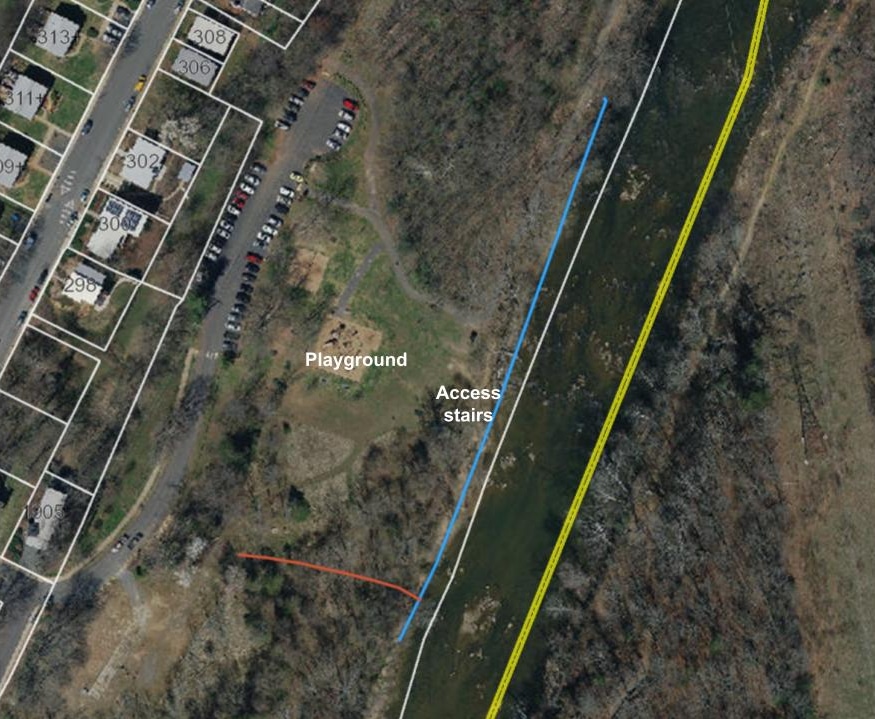
The blue line shows the approximate extent of the potential riverbank restoration area. The orange line shows the approximate extent of the potential stormwater outfall restoration area. The yellow line is the border between the City of Charlottesville and Albemarle County.
Project Timeline
- Winter 2021 – Preliminary planning & assessment
- Spring and Summer 2022 – Community outreach for preliminary design
- Fall 2022 – Design engineering to incorporate feedback
- February 2022 – Engineering studies begin
- March 15, 2022 – Virtual community forum to collect input on project goals and priorities
- March – May, 2022 – Initial project design created based on study results and public input
- Summer 2022 – Second community input forum to collect feedback on initial designs
- 2023-2024 – Fundraising
- 2024 – Complete deisgn
- 2025 – Permitting and construction
Connection with Community Plans and Priorities
The Rivanna Restoration at Riverview Park project supports other plans and priorities established for the Rivanna River. Water quality improvements from the restoration work will contribute to meeting the goals for local water quality cleanup plans. The project also aligns closely with the recently released Urban Rivanna River Corridor Plan. This planning process was initiated by the City of Charlottesville and Albemarle County and led by the Thomas Jefferson Planning District Commission. It engaged groups of local officials, technical experts, and area residents to create recommendations for the corridor. These groups identified restoration, preservation, and stewardship as the primary goals for this area and specifically identified Riverview Park as one of the three highest priority locations for restoration.
Community Input
Community input and support are essential to the success of this restoration project. In spring and summer 2022, RCA collected community input forms and hosted an initial community meeting. A second round of community input and a second community meeting took place during the fall and winter of 2022. Links to the feedback collected during these times are listed below. Thank you for your feedback on this project! Questions about the project can be directed to exec@rivannariver.org.
Spring and summer 2022 community input:

